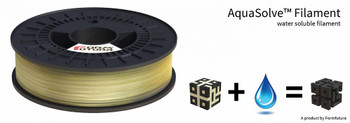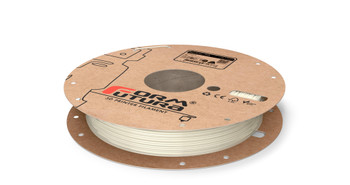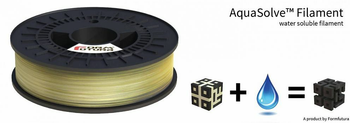FormFutura
PVA Support Filament Helios Support - Natural 3D Printer Filament
- SKU:
- 175HEL-NAT-0050
- UPC:
- 8718924470022
- Weight:
- 0.50 KGS
- Shipping:
- Calculated at Checkout
Payment options available:






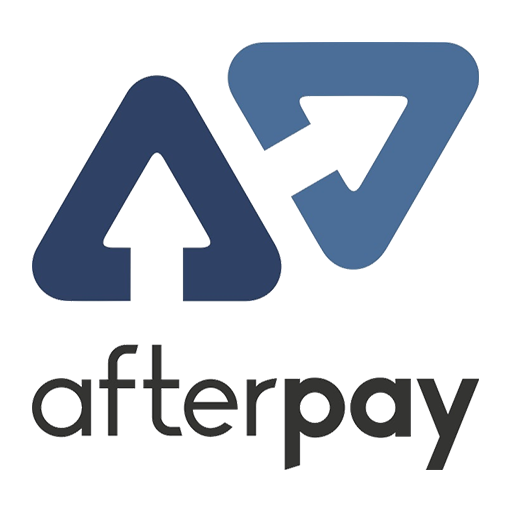
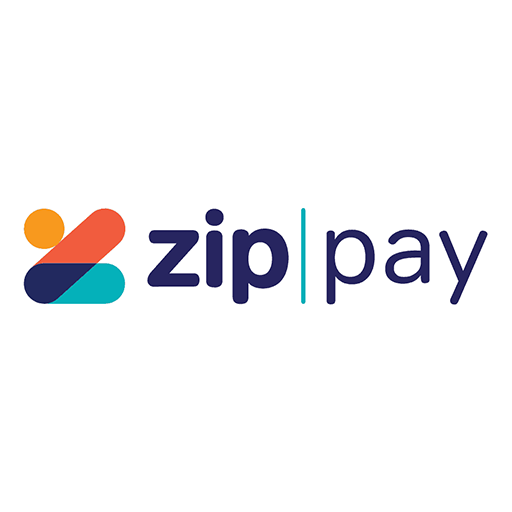
Share with:
Description
Helios Support is a “high heat” water-soluble PVA material which is engineered as support material for dual extrusion 3D printing in combination with engineering materials which require to be printed at higher temperatures and/or in heated build chambers. Helios support can be printed at nozzle temperatures up to 250° C without the risk of cross linking and nozzle clogging and adheres extremely well to styrene based materials such as ABS, TitanX, Crystal Flex, and ApolloX, but also to Python Flex and Volcano PLA.
Helios Support dissolves slightly slower in water than normal PVA, but the dissolving process can be sped up when using warm and circulating water.
Unique features
- Can be printed at nozzle temperatures up to 250° CNo risk of cross linking and nozzle clogging
- Improved filament flowing behaviour
- Can be printed in heated build chambers up to 60° C
- Excellent adherence to ABS, TitanX, ClearScent ABS, ApolloX, Crystal Flex, Python Flex and Volcano PLA
- Excellent solubility in warm circulated water
- Fully biodegradable when dissolved in water
General printing guidelines *
|
Nozzle size: ≥ 0.15mm |
Layer height: ≥ 0.1mm |
Flow rate: ± 100% |
|
Print temp: ± 235 - 255° C |
Print speed: Medium |
Retraction: Yes ± 5mm |
|
Heat bed: ± 35 - 60° C |
Fan speed: 0-25% |
Experience level: Expert |
*) Above displayed settings are meant as guidance to find your optimal print settings. These ranges in settings should work for most printers, but please do feel free to experiment outside these ranges if you think it is suitable for your printer. There are a lot of different type of printers, hot-ends and printer offsets that it is extremely difficult to give an overall one-size-fits-all setting.
*) Once Helios Support has been used or opened from its original vacuum sealed packaging for a while it is advised to dry the material before using again.
Filament length
|
ρ: 1.19 g/cc |
50 gr coil |
0.3 Kg spool |
|
Ø 1.75mm |
± 17.5m |
± 105m |
|
Ø 2.85mm |
± 6.6m |
± 40m |
Formfutura PVA Support matrix
Below overview is meant to give guidance on which of our PVA based support materials – AquaSolve PVA, Atlas Support, and Helios Support – is advised as support material in combination with various Formfutura filaments that can be used as primary building material.
Please do note that below overview is purely meant as general guidance and advice based on our in-house expertise and experience and that it is not to be seen as a fixed principle or rule. There are numerous factors that determine the best fitting PVA support with a primary building material and it actually varies per 3D printer. Below overview can according to our state of knowledge be used as guidance for the fast majority of 3D printers.
|
|
AquaSolve |
Atlas Support |
Helios Support |
|
|
EasyFil PLA / Reform rPLA |
Support |
++ |
+ |
- |
|
Max thermal stability |
210° C |
225° C |
- |
|
|
Interface layer speed |
40 mm/s |
20 mm/s |
- |
|
|
Premium PLA |
Support |
++ |
+ |
- |
|
Max thermal stability |
210° C |
225° C |
- |
|
|
Interface layer speed |
40 mm/s |
20 mm/s |
- |
|
|
HDglass / ReForm rPET |
Support |
- |
++ |
- |
|
Max thermal stability |
- |
225° C |
- |
|
|
Interface layer speed |
- |
30 mm/s |
- |
|
|
EasyFil ABS |
Support |
- |
- |
++ |
|
Max thermal stability |
- |
- |
250° C |
|
|
Interface layer speed |
- |
- |
20 mm/s |
|
|
Premium ABS |
Support |
- |
- |
++ |
|
Max thermal stability |
- |
- |
250° C |
|
|
Interface layer speed |
- |
- |
20 mm/s |
|
|
ClearScent ABS |
Support |
- |
- |
++ |
|
Max thermal stability |
- |
- |
250° C |
|
|
Interface layer speed |
- |
- |
20 mm/s |
|
|
TitanX / ReForm rTitan |
Support |
- |
- |
++ |
|
Max thermal stability |
- |
- |
250° C |
|
|
Interface layer speed |
- |
- |
20 mm/s |
|
|
ApolloX |
Support |
- |
- |
++ |
|
Max thermal stability |
- |
- |
250° C |
|
|
Interface layer speed |
- |
- |
20 mm/s |
|
|
Crystal Flex |
Support |
- |
- |
++ |
|
Max thermal stability |
- |
- |
250° C |
|
|
Interface layer speed |
- |
- |
20 mm/s |
|
|
Volcano PLA |
Support |
- |
- |
++ |
|
Max thermal stability |
- |
- |
250° C |
|
|
Interface layer speed |
- |
- |
20 mm/s |
|
|
Python Flex |
Support |
- |
- |
++ |
|
Max thermal stability |
- |
- |
250° C |
|
|
Interface layer speed |
- |
- |
20 mm/s |
|
|
|
||||
|
* Max thermal stability tested up to 256 seconds with no flow |
||||
|
* Needed thermal stability increases with ‘build material’ temperature |
||||
|
* Interface layer speeds are guidelines to start testing. Speeds can improve! |
||||
General guidance for printing with PVA support materials
Printing with PVA in general isn’t plug and play and does require a fair amount of 3D printing expertise as there isn’t a generic one-size-fits all setting for dual extrusion printing with PVA materials. The optimal PVA settings can even vary between the same models of 3D printers.
One of the most common challenges is to establish a good bond between the PVA support material and the primary building material. Below parameters are of utmost importance to establish a good adherence
- Verify the extrusion distance between the printed object and the PVA support.The default setting in most slicer software is often set at a distance of 0.1mm or 0.2mm, which works well for break-away support, but not for PVA support.
- For PVA support materials the extrusion distance must be set to 0.0mm as both materials must really come into contact with each other.
- The printing (nozzle) temperature is extremely important and it is advised to measure the actual temperature of the nozzle and to compare this temperature with the temperature set in the print settings.If the actual temperature of the nozzle is for instance 10° C lower than the temperature in the print settings it might very well be that the layer of PVA support material is not flowing optimally into the layer of the primary building material. It is often seen that the actually nozzle temperature varies from the print temperature set in the slicing software.
- Verify if the nozzles of your printer are properly levelled and have exactly the same height, so that there is no “height difference” when layering the PVA support material on top of the primary building material.
- In order to verify this it is recommended to 3D print a 5cm x 1cm rod and to print every 1 to 2 layers with the left nozzle and the following 1 to 2 layers with the right nozzle and to repeat this process multiple times. If you notice a non-perfect layering then the nozzles aren’t properly levelled. This process can be done with PLA for instance.
Product export information
|
HS Code: 39169090 |
Description: Monofilament |
Country of origin: Netherlands |
Compliance *
This filament is compliant to below listed directives and regulations.
- RoHS directive 2011/65/EC
- REACH directive 1907/2006/EC
*) This declaration of conformity to directives and regulations is prepared according to our present standard of knowledge and may be amended if new cognitions are available and applies only for the above described products.

 FREE SHIPPING ON ORDER OVER $75
FREE SHIPPING ON ORDER OVER $75
 LOYALTY PROGRAM
LOYALTY PROGRAM
 SHIPPING WORLDWIDE
SHIPPING WORLDWIDE












